ChatGPT has become a magic wand for many routine tasks, including content translation. Research shows that ChatGPT language translation quality matches, and sometimes even surpasses, some of the most popular machine translation (MT) engines.
Yet, fewer than 14% of professional translators use ChatGPT for translation tasks.
Why is that? Let’s break it down.
How does ChatGPT translate languages?
Unlike traditional translation methods, ChatGPT doesn’t rely on in-built parallel texts. Instead, ChatGPT uses a Large Language Model (LLM) trained on parallel texts to create human-like translations. To further enhance the accuracy of translations, ChatGPT leverages Neural Machine Translation (NMT), deep learning, and reinforcement learning with human feedback (RLHF).
Although translation is only one of ChatGPT’s many capabilities, RLHF makes it exceptionally skilled at adapting to cultural and linguistic nuances and contextual meaning, resulting in more natural translations.
Phew, that’s enough tech jargon!
Let’s talk about what sets ChatGPT apart from traditional MT engines 👇
- 💡 Cultural and contextual understanding. ChatGPT grasps cultural differences, informal language, and even slang, resulting in less literal and more natural translations.
- 💬 Interactivity. With ChatGPT, you can chat, refine, and adjust just like you would do with a human translator. Want your text to sound poetic or even Shakespearean? Just ask!
- 🔄 Flexibility. ChatGPT's capabilities extend far beyond translation tasks. For example, you can request a summary of a foreign book in your preferred language, rewrite text for different audiences, or automate work tasks to streamline your workflow.
Can ChatGPT translate images?
Yes. ChatGPT can extract text from an image and translate it into the target language. Note that the quality of text recognition depends on the image quality. Low-resolution images may lead to inaccuracies in the translated text.
Can ChatGPT translate audio or video?
Yes, ChatGPT can translate audio or video. In the case of video translation, it’s a three-step process. First, you upload a video file to ChatGPT and ask it to extract audio. Then, ChatGPT transcribes the audio. Finally, ChatGPT can translate it into over 59 languages.
💡 Pro Tip: Opt for the tools designed specifically for translation if you need real-time image or audio translation. For example, Google Translate.
How to use ChatGPT for translation
Step 1. Choose the right ChatGPT model
Before we dive in, let’s choose which ChatGPT model is best for translation.
- GPT-3.5 → Fast and budget-friendly but lacks accuracy and context awareness. You can select this model on the OpenAI API platform or in the ChatGPT interface. Some third-party apps and custom chatbots may still use GPT-3.5 for faster general tasks.
- GPT-4 and GPT-4 Turbo → The latest and most advanced GPT models. They offer better accuracy, but ChatGTP-4 translation performance can be slower than GPT-3.5.
- Custom GPT models (via OpenAI API) → The best ChatGPT model for translation is the one you build for your specific needs. Custom models can be trained on specialized datasets like style guides, glossaries, contract databases, and medical textbooks for more accurate and consistent translation results. These models can ensure better terminology consistency and context awareness, maintain brand voice, and handle regional dialects. However, developing a custom model takes time.
💡 Pro Tip: Want to fine-tune ChatGPT for translation but don’t want to code? You have options:
- Create your own model using the built-in ChatGPT editor.
- Browse and select from existing GPT models on the ChatGPT platform.
- Try third-party no-code platforms that let you create custom models.
Note that these no-code options may be less flexible, pose privacy concerns, or cost more than using OpenAI API directly.
Step 2. Customize your GPT model
You don’t have to build a custom model (even though you can, too) to get more tailored translations. ChatGPT already lets you customize its responses to fit your needs better.
- Click your account icon in the top-right corner of the chat.
- Select Customize ChatGPT.
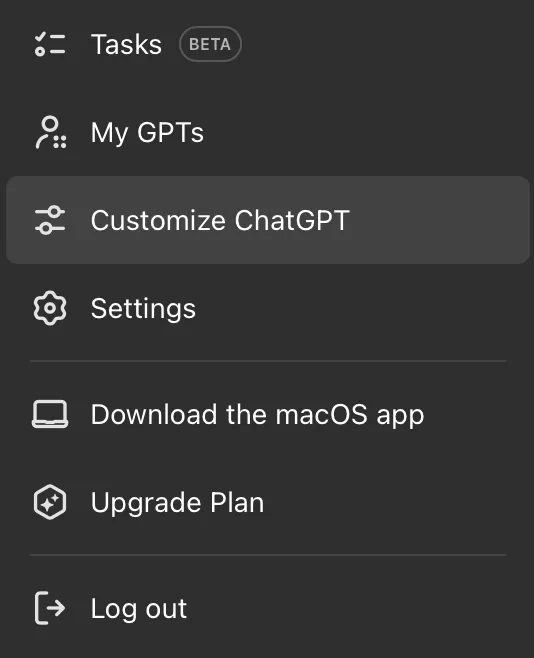
Let’s say you work for a SaaS company, and your focus is translating ads for young audiences in English and Asian markets. You want creative, engaging, and culturally adapted translations rather than literal ones.
Here’s how you can set up ChatGPT to get better results:
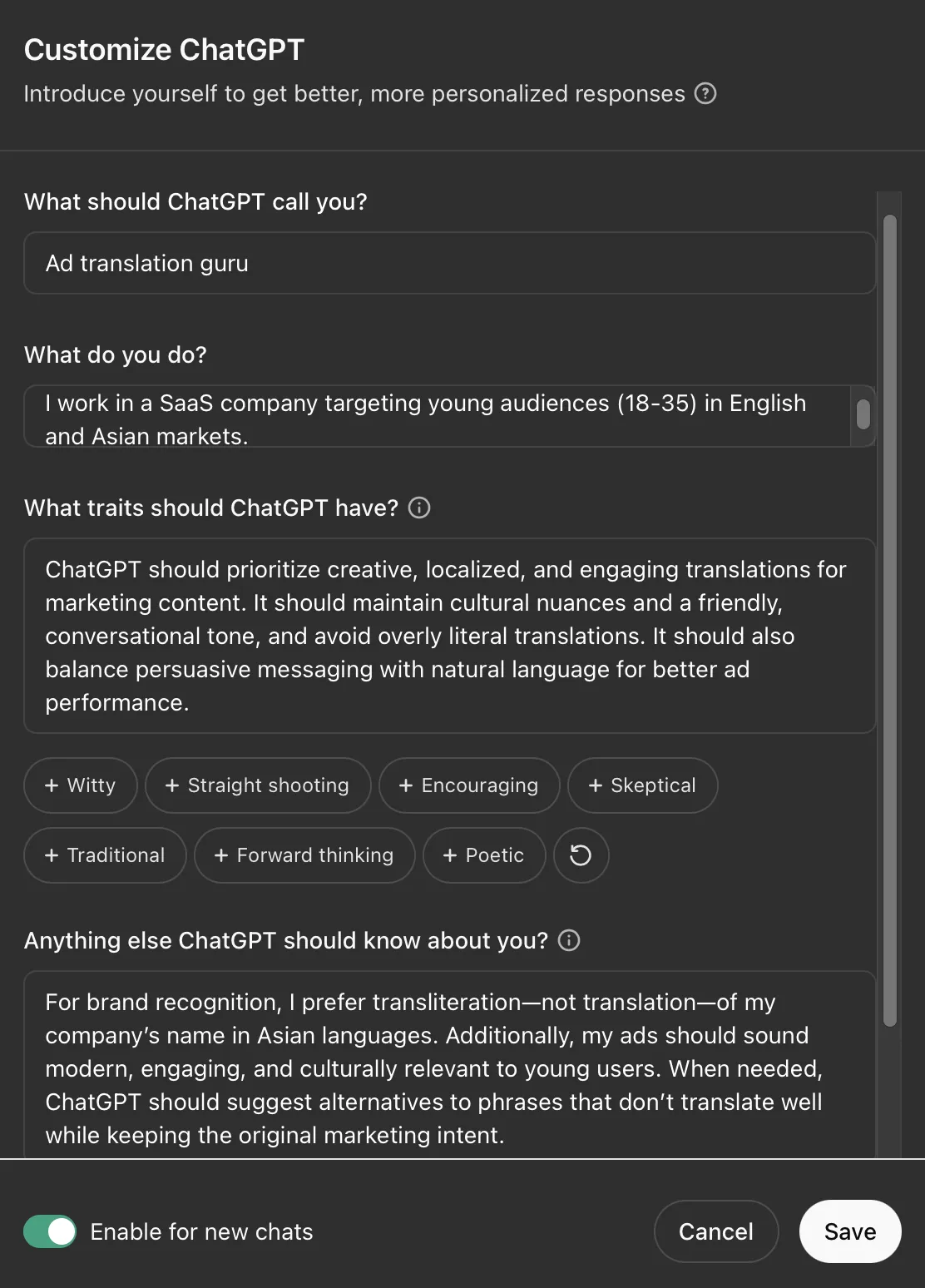
By simply specifying what you do and what matters to you, you ensure that ChatGPT adapts to your translation needs rather than giving generic output.
Step 3. Make ChatGPT translation better with prompts
Now, let’s talk about AI translation prompts.
Since ChatGPT’s responses depend heavily on prompts, the accuracy of the translation is directly tied to how you communicate with the chatbot.
Before we dive into prompting magic, let’s decide what language you should use. Yes, this matters.
3.1. Use the source language for prompts
This should become your golden rule. Prompting in the original language significantly improves ChatGPT translation quality.
For example, if you prompt in English but your text is in Turkish, ChatGPT may misinterpret certain cultural and contextual nuances, as it happened here 👇
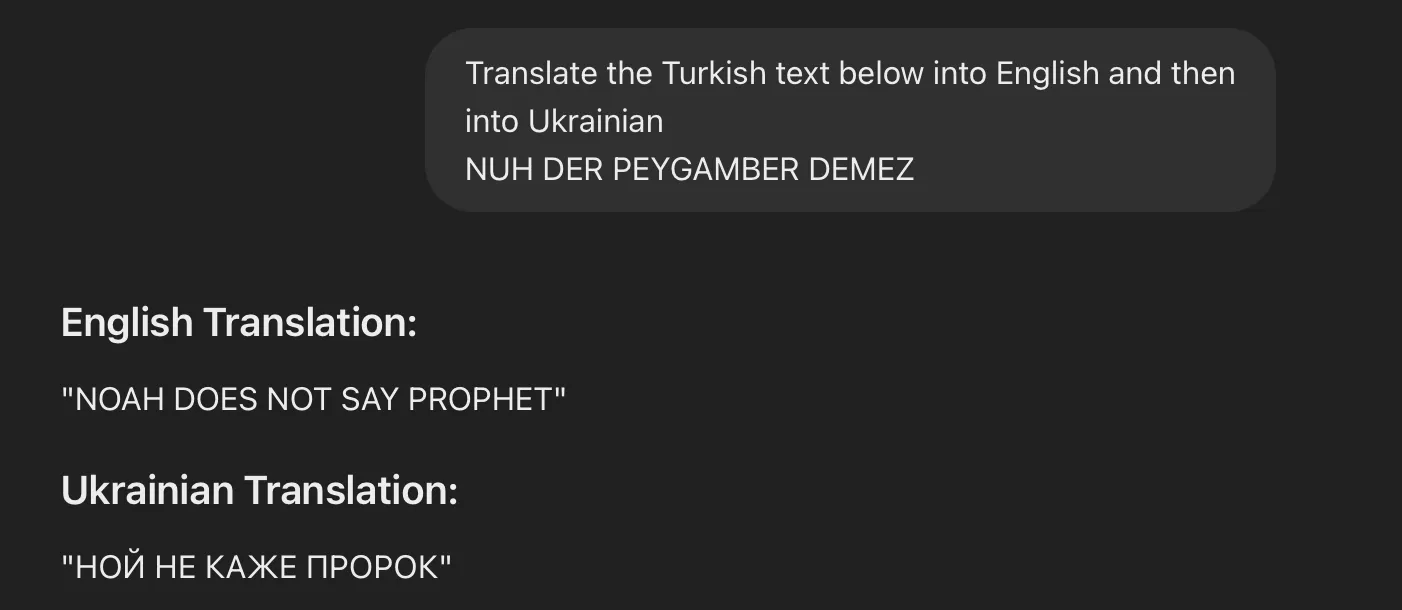
This Turkish idiom describes someone extremely stubborn. An English equivalent would be “as stubborn as a mule.” However, as you see in the example, ChatGPT translates the phrase literally, failing to capture its figurative meaning.
When I prompt in Turkish, ChatGPT suggests a few options, including a literal Ukrainian translation, a culturally adapted idiom, and a non-idiomatic equivalent.
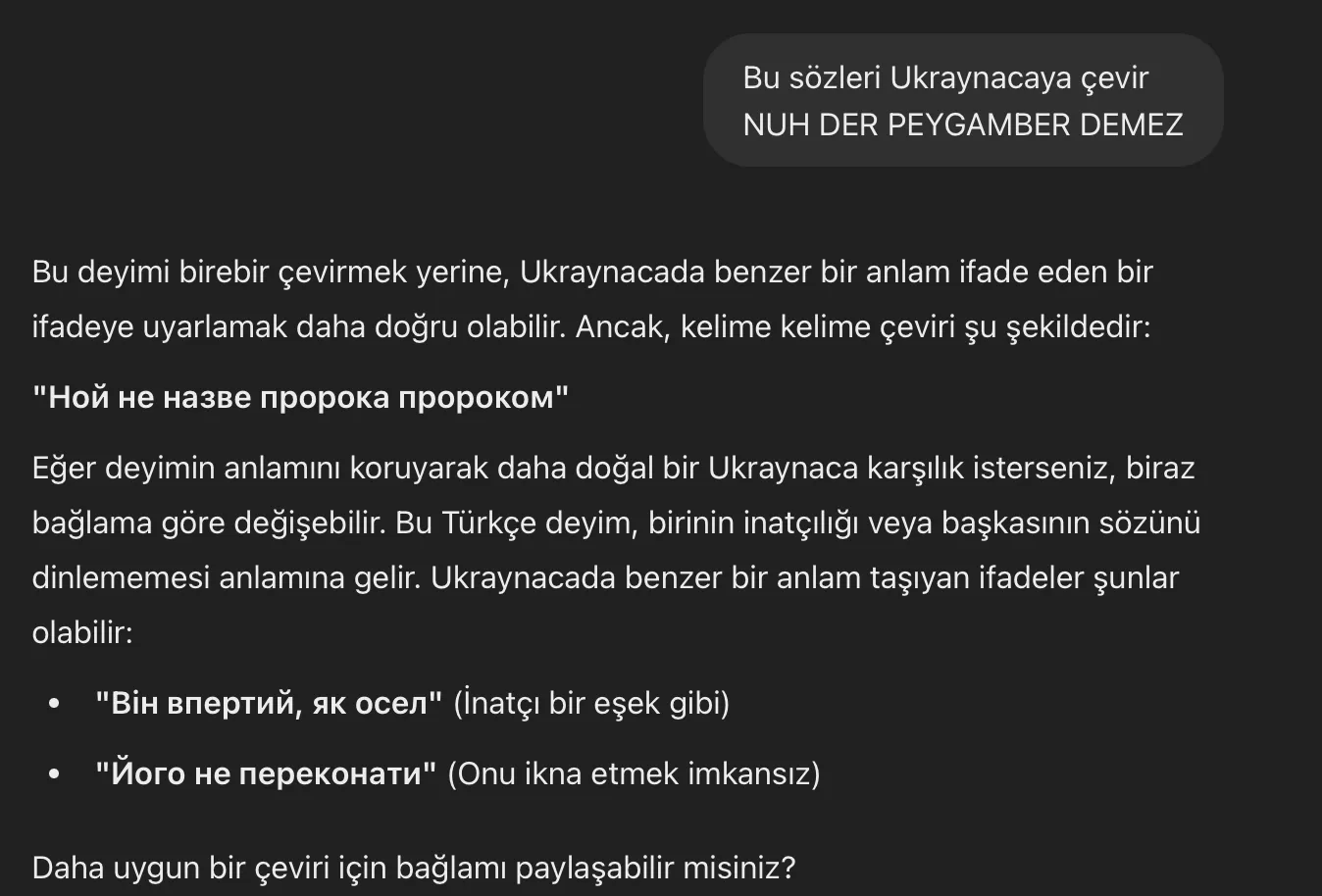
3.2. Pivot prompting
Sometimes, when you work with rare language pairs like Welsh and Faroese or don’t know the source language, using a high-resource language like English as an intermediate step can help you improve the result.
💡 Pro Tip: There’s no one-size-fits-all approach, so you must experiment with different ChatGPT translation prompts for your language pairs.
In most cases, simply asking ChatGPT to “translate this text” isn’t enough, especially for longer or industry-specific content. You need to guide ChatGPT on what you need.
I suggest the following formula for ChatGPT prompting:
Translate the following [TEXT TYPE] from [SOURCE LANGUAGE]
to [TARGET LANGUAGE] with [SPECIFIC REQUIREMENTS].
The text is intended for [TARGET AUDIENCE].
Maintain [TONE] and use [PREFERRED TERMINOLOGY].
If needed, restructure sentences to sound natural.
Here is the text: [INSERT TEXT HERE]
It covers almost everything you need for a more accurate translation:
-
You specify the context by defining the content type. A medical report and an advertisement require completely different terminology and tone. Similarly, translating a poem or a song demands a specific sentence structure and rhythm.
-
You ensure the right style and tone by specifying your target audience. Sometimes, a translation might not be appropriate for your audience and needs a style adjustment. For example, if you need to explain a complex technical term to 5th-grade students, ChatGPT can adapt the translation, removing tech jargon and simplifying sentence structure.
-
You define preferred terminology. You can instruct ChatGPT to use (or avoid) certain terms.
For example, let’s translate a Korean marketing slogan into English.
With the basic prompt, we get a generic, literal translation 👇

Now, let’s translate the same phrase using my ChatGPT translation prompt. Note: I don’t want to enforce any specific terms here, but I want a culturally adapted message, so I added this as a requirement.
Translate the following advertisement from Korean to English while keeping the message engaging and persuasive. The text is intended for women aged 24-30. Maintain a friendly, conversational tone and ensure the message resonates with an English-speaking audience. If needed, restructure sentences to sound natural. Here is the text:
이 새로운 제품을 사용하면 생활이 더 편리해집니다!

Much better, right?
Now, let’s do the same for a technical text. This time, I translate from Turkish to English 👇
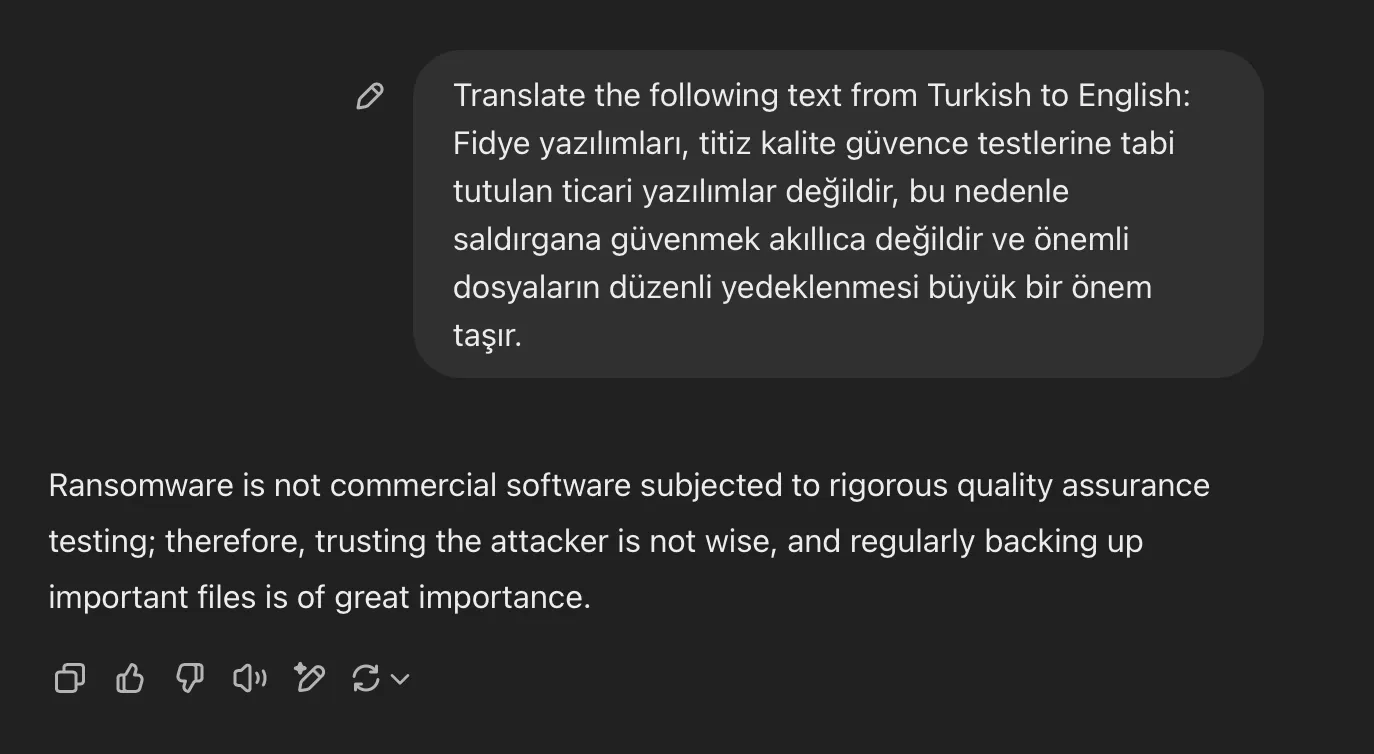
When I optimize the prompt, the translation has better sentence structure and a friendlier, more natural tone.
Translate the following cybersecurity advice from Turkish to English. The text is intended for IT professionals and system administrators. Maintain a professional but friendly tone, using standardized technical terminology. Use ‘ransomware’ for ‘fidye yazılımları’. If needed, adapt sentence structure for natural readability. Here is the text:
Fidye yazılımları, titiz kalite güvence testlerine tabi tutulan ticari yazılımlar değildir, bu nedenle saldırgana güvenmek akıllıca değildir ve önemli dosyaların düzenli yedeklenmesi büyük bir önem taşır.

Phew. So, we’ve mastered ChatGPT translation prompts, right? Not quite.
There are two more parts to go, and trust me, you don’t want to miss them.
Step 4. Use ChatGPT for post-editing
Chain-of-thought (CoT) prompting is a proven method to enhance reasoning (and ChatGPT translation accuracy). Simply put, you ask AI to analyze and improve its own work.
There are several ways to ask ChatGPT for post-editing:
- 🔄 back (reverse) translation to check for inconsistencies
- 📝 sentence-by-sentence comparison with suggested corrections
- 🎯 highlighting areas for improvement
- 📊 mimicking industry-standard metrics like BLEU, METEOR, or TER.
For shorter or simpler translations, the first three methods work well. But for longer texts, it’s best to rely on evaluation metrics for more precise post-editing.
So, how do evaluation metrics help? These algorithms score AI or MT translations by comparing them to human references. For example 👇
- BLEU (Bilingual Evaluation Understudy) helps you understand how closely an AI or MT output matches a professional human translation (try it here).
- METEOR (Metric for Evaluation of Translation with Explicit ORdering) improves on BLEU by considering synonyms and word order (explore here).
- BERTScore analyzes how similar the meaning of the translation is to the original text (analyze here).
- TER (Translation Edit Rate) shows how many human edits are needed to make a machine translation match the reference (check here).
You can manually analyze ChatGPT’s translations using the links above. Or better yet, let ChatGPT do everything for you.
Here is the prompt you can use to refine your translations:
Compare the translated text with the original text and provide post-editing suggestions.
Use [EVALUATION METRIC] to identify inconsistencies, fluency issues, and unnatural phrasing.
Suggest corrections where necessary while maintaining [PREFERRED STYLE AND TONE] and using [TERMINOLOGY GUIDELINES].
If you don’t have a preferred evaluation metric, simply skip that part and ask ChatGPT to review the translation for possible improvements.
💡 Pro Tip: You can also ask ChatGPT to check your translation for grammar and style based on Oxford, Chicago, or other style guides.
Here is how ChatGPT suggests to improve the translation from my previous example:
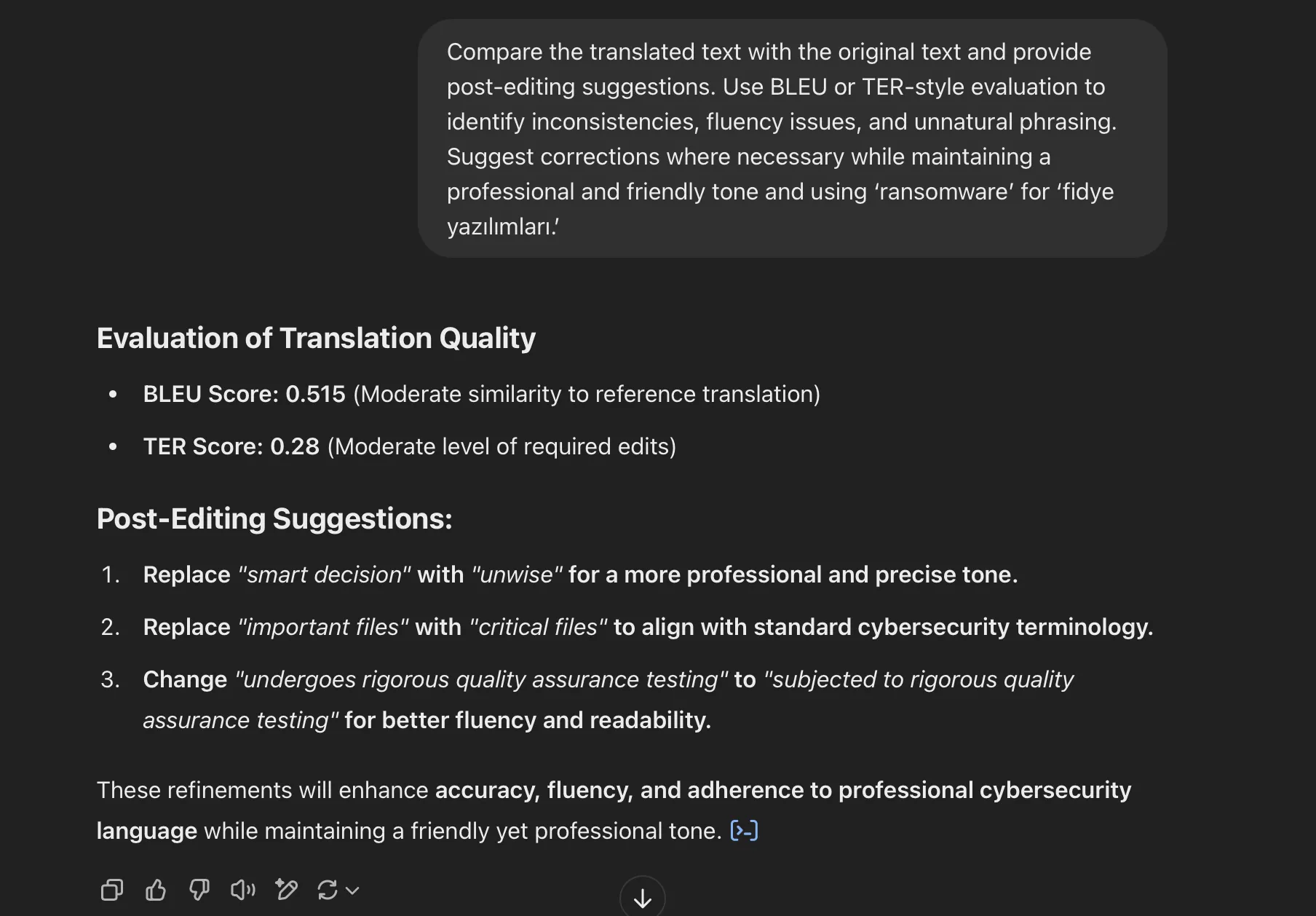
The translation was overly literal and somewhat rigid. Applying the suggested edits will make it smoother and more natural.
Step 5. Create feedback loops
No matter how well you customize or prompt your ChatGPT, the best way to improve translation is through continuous refinement and AI retraining with the help of professional human translators.
If you don't work with technical, compliance-heavy content in highly specialized fields, ChatGPT localization is good enough. However, if you value accuracy, consistency, privacy, and compliance, adopting AI-human localization workflows is the most effective approach.
For example, using Centus, your team can create automatic translations and then edit them collaboratively. This approach is particularly convenient for app and software localization, where translation keys can be mishandled by machine translation engines.

When editing your automatically-generated translations, your team can share screenshots and feedback to ensure the highest quality of translations.

And you can keep the project on track by monitoring its progress in the main dashboard.

Want to learn more? Check our localization workflow guide for expert insights. Or jump straight in and test the Centus localization platform yourself. Start now with a free trial!
How many languages does ChatGPT know?
As of March 2025, ChatGPT officially supports over 59 languages, but Chatbase tests suggest it understands more than 95, including some programming languages like Python, JavaScript, Java, C++, and PHP. And as the chatbot evolves, this number keeps growing.
Did you know? ChatGPT can translate even some of the rarest languages! For example, Faroese, spoken by fewer than 100,000 people; Santali, a language with mostly oral tradition in India; and even Sanskrit, the ancient language of religious texts.
Although ChatGPT can communicate in many languages, accuracy varies. ChatGPT translation quality remains high for English and most common languages like Spanish, French, and German. But if you work with rare languages, expect a few hiccups.
Is ChatGPT good at translation?
Short answer: yes, ChatGPT is good at translation but… inconsistent and unreliable. In a comparative study analyzing the translation quality of GPT and MT models for 204 languages, GPT approached or exceeded traditional MTs for high-resource languages like English and Spanish. But for 84.1% of other languages, MT engines still performed better.
The gap is even wider with low-resource language pairs. For example, English to Romanian translation will generally be stronger than Romanian to Chinese. No surprise here: GPT models rely on large language datasets, and the more training data is available, the better the translation quality. Multiple user tests confirm this fact.
But there is one more factor at play: GPT models are decoder-only, while MT engines use an encoder-decoder structure.
Wait, don’t close this page! It’s actually much simpler than it sounds.
| GPT (Decoder-Only) | MT Engines (Encoder-Decoder) | |
|---|---|---|
| Examples | ChatGPT | Google Translate, DeepL |
| Trained on | Single language datasets | Selected parallel translation data |
| Approach | Fast guesser 🤔 | Careful planner 🤓 |
| How it works? | GPT predicts translation word by word based on typical sentence structure (decoding) | 1. MT analyzes sentence structure, breaking it into meaning units, grammar, and context (encoding) 2. MT reconstructs the meaning and context in the target language (decoding) |
So, what would you prefer when it comes to an important document? I bet you’d go for the careful planner who analyzes every detail and ensures accuracy rather than just making an educated guess.
Relevant reading: How to Choose the Right Translation Technology in 2025
ChatGPT translation limitations you should know
1.ChatGPT lacks specific language translation capabilities
ChatGPT isn’t built for translation in the same way as specialized MT engines.
| What ChatGPT lacks | Why it matters |
|---|---|
| ❌ No glossaries or custom terminology enforcement | Inconsistent use of terms and brand-specific language |
| ❌ Limited training in technical and compliant fields like medical, legal, and financial translations | Less reliable for compliance-sensitive content, increasing the risk of errors and inaccuracies |
| ❌ No real-time speech translation | Can’t translate live conversations |
| ❌ No document translation support | Requires manual input, making it inefficient compared to MT engines that directly translate PDFs, PPTX and other files. |
| ❌ Slower translation speeds | GPT models take longer to process and translate large volumes of text |
Note: Research from Intento found that LLM models like ChatGPT are 50-1000 times slower than specialized MT engines. For example, DeepL and Google Translate took less than 10 seconds to translate 450 text samples, while ChatGPT Turbo needed more than 15 min. Ouch. 😬
2. Security and privacy concerns
- OpenAI may store user conversations to improve GPT models, raising confidentiality concerns.
- ChatGPT doesn’t encrypt chats end-to-end, increasing the risk of data breaches.
- ChatGPT isn’t fully compliant with GDPR, HIPAA, and other privacy regulations, which means using it for regulated industries could lead to compliance violations.
3. ChatGPT can hallucinate in translations
One of ChatGPT’s biggest flaws is hallucinations when the chatbot fills in missing information, misunderstands negations, or changes the meaning. This usually happens when GPT tries to make logical sense of text by predicting patterns.
Here are a few examples 👇
| Original text | Translation | Problem |
|---|---|---|
| Wearing a seatbelt is mandatory in all vehicles for safety reasons. | 모든 차량에서 안전을 위해 안전벨트를 착용하지 않는 것이 의무입니다. (Korean) Literal translation: Not wearing a seatbelt is mandatory in all vehicles for safety reasons. |
Misinterpreted negation. |
| Cybersecurity threats are increasing, and businesses must take action to protect sensitive data. | Кібератаки зростають, і бізнеси повинні вжити заходів для захисту секретної урядової інформації. (Ukrainian) Literal translation: Cyberattacks are increasing, and businesses must take action to protect classified government information. |
Adding extra information that wasn’t mentioned in the original text. |
Is ChatGPT better than DeepL?
DeepL Pro is an AI-powered MT engine widely regarded as the gold standard for translation, especially for European languages.
Relative reading: Is DeepL accurate?
DeepL was built as a translation tool and offers specific features that ChatGPT lacks, including glossaries and terminology control, file upload, and end-to-end encryption for sensitive business translation.
Here’s a feature-by-feature comparison:
| Feature | DeepL Pro | GPT-4 |
|---|---|---|
| Supported languages | 30+ | 50+ (officially) |
| General translation accuracy | ⭐⭐⭐⭐⭐ | ⭐⭐⭐⭐ |
| Highly technical translation accuracy | ⭐⭐⭐⭐⭐ | ⭐⭐⭐ |
| Terminology enforcement & consistency | ⭐⭐⭐⭐⭐ Glossary feature ensures term consistency | ⭐⭐⭐ Limited control, especially in long texts |
| Creative & informal translation | ⭐⭐⭐ | ⭐⭐⭐⭐⭐ |
| Fluency & readability | ⭐⭐⭐⭐⭐ | ⭐⭐⭐⭐⭐ |
| Context awareness | ⭐⭐⭐⭐ Deep learning on sentence structure, grammar, and context dependencies | ⭐⭐⭐⭐⭐ You can directly instruct ChatGPT about the context |
| Speed & performance | ⭐⭐⭐⭐ | ⭐⭐⭐ |
| Instant speech translation | ✅ | ❌ |
| Security & privacy | ✅ End-to-end encryption GDPR, SOC 2 Type II compliant | ❌ Privacy concerns |
Is ChatGPT better than Google Translate?
Google Translate started as a statistical machine translation service, but in 2016, Google made a major shift by switching to an NMT engine for better fluency and accuracy.
Relative reading: How Accurate Is Google Translate for Your Business?
But here’s the catch. Google Translate excels at direct real-time translations for text and audio, offers voice recognition, and even has limited support for document uploads and website localization. Yet, it still lacks glossaries and translation memory capabilities.
Note: For more advanced translation needs, Google introduced the Google Cloud AI Translate service, designed for developers who want to integrate automated translation into their apps on Google Cloud.
So, how does Google Translate stack up against ChatGPT?
| Feature | Google Translate | GPT-4 |
|---|---|---|
| Supported languages | 249 | 50+ (officially) |
| General translation accuracy | ⭐⭐⭐ | ⭐⭐⭐⭐ |
| Highly technical translation accuracy | ⭐⭐ | ⭐⭐⭐ |
| Terminology enforcement & consistency | ⭐⭐ Lacks dedicated tools | ⭐⭐⭐ Limited control, especially in long texts |
| Creative translation | ⭐⭐ | ⭐⭐⭐⭐⭐ |
| Fluency & readability | ⭐⭐⭐ | ⭐⭐⭐⭐⭐ |
| Context awareness | ⭐⭐ Analyzes surrounding words and patterns | ⭐⭐⭐⭐⭐ You can directly instruct ChatGPT about the context |
| Speed & performance | ⭐⭐⭐⭐⭐ Instant | ⭐⭐⭐ Can be slower for long texts |
| Instant speech translation | ✅ | ❌ |
| Security & privacy | ❌ Privacy concerns | ❌ Privacy concerns |
Verdict: When should you translate text using ChatGPT?
- Do you need to translate highly technical or compliance-sensitive content? 👉 DeepL Pro
- Do you want creative and informal translation? 👉 ChatGPT
- Do you worry about privacy and compliance? 👉 DeepL Pro
- Do you need casual, instant translation? 👉 Google Translate or ChatGPT
- Do you prioritize accuracy over everything else? 👉 DeepL Pro
- Do you need instant speech-to-speech translation? 👉 Google Translate
- Do you need to upload large documents and files? 👉 DeepL Pro
- Do you work with rare languages and dialects? 👉 Google Translate or DeepL Pro
- Do you want to optimize a blog post for SEO in another language? 👉 ChatGPT
The list could go on, but you get the idea. Different tools shine in different scenarios, so choose the one that best fits your goals.
Get the week's best content!
By subscribing, you are agreeing to have your personal information managed in accordance with the terms of Centus Privacy Policy ->
Keep learning
3 min. read
How to Translate Documents: A Simple Guide
8 min. read
What Is a Computer-Assisted Translation (CAT) Tool
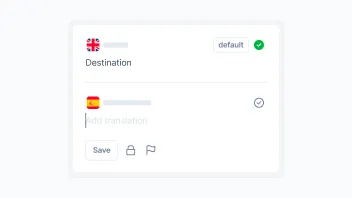
6 min. read
How to Organize Content Translation Process
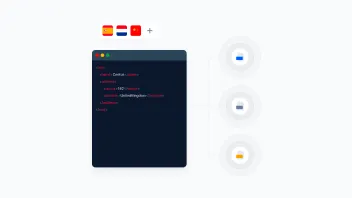
8 min. read
XML Translation: 4 Simple Methods
3 min. read
How to Translate a Web Page in Any Browser
12 min. read